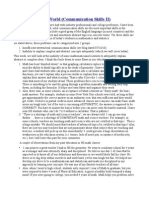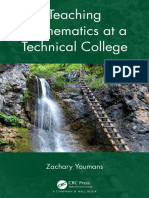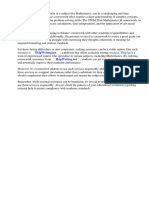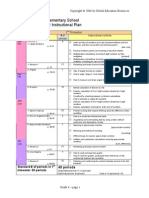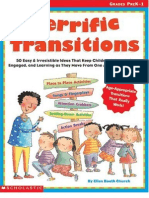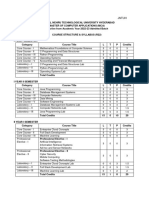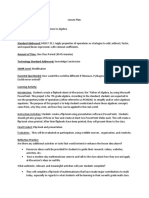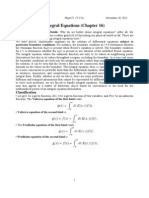Helping Kids With Math: What's Important?
Helping Kids With Math: What's Important?
Uploaded by
Shawanda ClarkCopyright:
Available Formats
Helping Kids With Math: What's Important?
Helping Kids With Math: What's Important?
Uploaded by
Shawanda ClarkOriginal Description:
Original Title
Copyright
Available Formats
Share this document
Did you find this document useful?
Is this content inappropriate?
Copyright:
Available Formats
Helping Kids With Math: What's Important?
Helping Kids With Math: What's Important?
Uploaded by
Shawanda ClarkCopyright:
Available Formats
Helping Kids with math: Whats important?
For those who have the opportunity to help kids with their mathematics, I would like to put K-7 mathematics into context so everyone understands why they are doing what they are doing. I see things from a college teachers point of view, so let me start there. Like almost all who do research in mathematics I pay my debt to society by teaching. However diverse our research interests in mathematics are, my colleagues from around the United States, and, indeed, from around the world, almost all teach college undergraduates their basic mathematics. There are, regrettably, very few mathematics majors. Almost all of our students are rst and second year college students. They are not really our students though. They are majoring in other departments and those departments have required them to take specic mathematics courses. These departments make it quite clear to the mathematics departments what material they want covered. We, in mathematics departments, have very little say about the curriculum for the vast majority of our students. We run service departments. I have been a bit rigid in my story for the sake of efciency. Numerous qualiers should be put in. Of course we talk and negotiate with the departments we service. Of course we have some exibility in what we do, especially with terminal courses like pre-med calculus. Such qualiers do not alter the main point: the mathematics curriculum is determined from the top, not the bottom. We, in college mathematics departments, like those in K-12, are not at the top. Because we must teach specic material to other departments students, we have to start with students who have adequate preparation to learn that material. This makes us experts on what students need to learn in K-12 since that is where our students have just come from. To determine students level of preparation, most colleges give placement exams. Students who do not pass the placement test for a college level mathematics course rarely nish a year of college level mathematics. Consequently, if a student does not go to college prepared for college mathematics then all of the career choices that college mathematics offers are closed to the student. It is important to realize that mathematicians have little control over what they teach. That is not decided by us but by the departments that need the mathematics. Things are really no different in K-12 if the students are to be prepared for college. The mathematics curriculum is determined top down, starting with the end user, and college mathematics teachers are caught somewhere in the middle of this pipeline. What we teach in college is not and cannot be determined by what is taught in K-12. If students are not taught the proper things in K-12, their mathematical career ends in K-12. Most colleges are fairly light on the use of technolgy in those rst two years of college mathematics. We do this for a couple of reasons, rst, our clients are not asking for it, and, the students are not our clients, the other departments are our clients. Second, and perhaps more to the point, I have not yet encountered a mathematics concept that required technology to either teach it or assess it. The concepts and skills we teach are so basic and fundamental that technology is not needed to either elucidate or enhance them. There might be teachers who can gure out a way to enhance learning with the use of technology, but it is absolutely unnecessary. The courses are
-2-
fairly hard and move fast. Introducing extraneous and unnecessary technology would divert attention from the goals of developing a basic understanding and problem solving skills with the new material. Dont take a minute away from that to use technology. Having discussed the lot in life of a college mathematics professor and some of our thoughts on technology, let me move on to talk about what this implies for the use of technology in the K-12 classroom. Recall that since 1990, over 60% of all high school graduates in the United States have gone on directly to college. (e.g. http://nces.ed.gov/programs/digest/d02/tables/dt184.asp) Around 75% go on within two years of graduating from high school. College preparation is thus the default choice for K-12 education. This 75% should be prepared to pass their college placement test and proceed with college mathematics. If they are not prepared, their career choices are dramatically limited. These career choices are limited for them by their K-12 experience if they do not have the opportunity to get prepared for college in K-12. The good news is that there is very little mathematics that must be mastered in K-12 to be prepared for college. Students need to know basic arithmetic by which I mean the 4 operations with whole numbers, decimals and fractions. They need to know ratios, proportions and percent. Underlying this is the base 10 place value system. They need to know some measurement and basic geometry facts. That, and using those skills at problem solving, pretty much takes care of K-7. After that they need two years of a good algebra course and it is desirable that they have some real Euclidean geometry. I have skimped of course by not specifying what should be taught in algebra but this is not the place. This is, however, an opportunity to tell K-7 teachers how very important what they teach is. These are the foundation years and, if students do not learn the foundations, they seldom recover. I can imagine that it might sometimes be difcult for K-7 teachers to see the connection between what they teach and what their students will need in college but the connection is there and very strong. Now I get into touchy territory. I am well aware of how the so-called standard algorithms for arithmetic have fallen on hard times. Educators frequently dismiss them as obsolete and unnecessary. On the contrary, from the point of view of the teacher who gets your students next, I cannot emphasize enough how important these basic algorithms (or their equivalent) are. There are many reasons for this and properly dealing with them would require a paper in itself. Briey, (1) the standard algorithms are the only collection of beautiful, serious, mathematical theorems you can teach to a child in K-7. They are amazingly powerful. They take the ad hoc out of arithmetic. They extend observed patterns and give the operations structure. These theorems solve the age-old problem of how to do basic computations without having to use different strategies for different numbers. The mystery is gone. Students will be confronted with new algorithms constantly as they progress in their study of mathematics. Ignoring the most basic and most important of all algorithms is not good preparation.
(2)
-3-
(3)
In high school and college mathematics, these very same algorithms will be slightly modied and generalized and used in different settings. This happens many times over and a mastery of the original algorithms makes this process an incremental one rather than an overwhelming one. If the standard algorithms are taught with understanding, enthusiasm and admiration then a student should nd them exciting and appreciate the awesome power they give.
Where, if anywhere, do calculators come into this picture? At the K-7 level there is NO PLACE for calculators. I am not alone in this belief. There is a listserve for a few hundred research mathematicians who specialize in algebraic topology (my eld of research). These colleagues are from all over the United States and the world. They teach at every kind of college from community colleges to the elite private universities. Some of them are now deans or in industry (but stay in touch through this listserve). It is a great cross section of mathematicians. These colleagues get K-12 students next. If you ask them what mathematics is, you will get a raging debate with little or no agreement. However, I asked them if they agree or disagree with: In order to succeed at freshmen mathematics at my college/university, it is important to have knowledge of and facility with basic arithmetic algorithms, e.g. multiplication, division, fractions, decimals, and algebra, (without having to rely on a calculator). I had 93 responses in support of this and no responses opposed. Even I was amazed as some of my colleagues usually disagree just to be contrary. This, however, is important to them all. Many of them made comments which are enlightening and worth reading (http://math.jhu.edu/wsw/ED/list). Of the shorter ones, we have: I am shocked that there is any issue here. That it is even slightly in doubt is strong evidence of very distorted curriculum decisions. I am sorry to see your talent wasted on what I recognize as a battle over mathematical competence. It is sad that such things which ought to be completely obvious are controversial. From a Japanese colleague in Nagoya: I thought it was a joke for you to have asked our opinion about such a self-evident truth, but I am afraid I was wrong. I am very sorry that you had to do this. The shock that many displayed is an indication of how little involvement there is of research mathematicians in the development of the K-12 curriculum. I have been involved for only a few years. One area I have been quite involved with is the various states written standards for K-12 mathematics education. These standards are what guide the teachers and tell them what is important to teach. Many states have so many topics each year that the all important core of arithmetic does not stand out. Many states never mention dividing fractions and long division. Few mention the standard algorithms. To the point of this note, many states insert technology starting in kindergarten or rst grade. Many other states are (deliberately?) ambiguous about the use of technology. Such standards indicate a signicant disconnect from the pipeline that leads to college mathematics and real career choices. There should be continuity. As explained above, college teachers cannot adjust college level mathematics courses to suit inappropriate preparation in K-12. K-12 is preparation for college. There seems to be a breakdown in communication
-4-
about articulation between K-12 and college. Perhaps this is just an artifact of the time when the majority of students didnt go to college and the articulation issue wasnt so important. However, the time has come for more college mathematics professors to be included in the development of the K-12 mathematics standards and curriculum. Without our input the pipeline may stay disconnected. I have emphasized K-7 mathematics education here because I wanted to stress its foundational importance due to its continuity with college level mathematics. 8-12 is a whole other (time consuming) world which also depends entirely on good K-7 preparation. There is, in some circles, tremendous resistance to the importance of pencil and paper calculation. But, the hands on, pencil and paper grappling with mathematics is essential for the mathematical maturation process that is necessary for the preparation for college level mathematics, in particular, for preparing the groundwork for real mathematical reasoning and problem solving. Perhaps it isnt necessary for those few who dont go on to college, but for the majority who are college bound it is. Students must be given the opportunity to learn the foundations of mathematics so they can have the career choices they should when they go to college. We, in college, frequently hear criticism about the mathematics we teach. Many K-12 educators tell us we are behind the times, that the standard algorithms are obsolete and calculators should be used for everything. We are told to stop living in the past and adapt to the new world. If and when we hear that from the departments we serve, we will adapt. As it is, we are pretty clear on what mathematics is and what mathematics a student must know coming out of K-12 in order to have a chance at succeeding in college mathematics courses. I believe that K-12 educators should be listening, or at least talking, to us more. In summary, if you are in a position to help a kid learn mathematics, stick to the basics. Keep away from the calculator (except maybe to check answers). Make sure the kid learns arithmetic! Good luck. Success in college depends on the hard work of K-12 teachers building a solid foundation with which we can work. W. Stephen Wilson Department of Mathematics Johns Hopkins University Baltimore, MD 21218 wsw@math.jhu.edu
You might also like
- Project Report Face Detection and RecognitionDocument38 pagesProject Report Face Detection and RecognitionDhruv Goel75% (8)
- Fractions Puzzle SheetsDocument48 pagesFractions Puzzle SheetsBrianwhitehouse91% (33)
- Remix ProjectDocument23 pagesRemix Projectapi-324426739No ratings yet
- On The Use of Handheld Technology in Math Instruction: Lars JakobssonDocument7 pagesOn The Use of Handheld Technology in Math Instruction: Lars JakobssonRomell Ambal RamosNo ratings yet
- Ed22 LitDocument2 pagesEd22 LitKristy JaurigueNo ratings yet
- Math StandardsDocument2 pagesMath Standardsapi-280070341No ratings yet
- Future High School Math Teachers and Upper Level Math CoursesDocument2 pagesFuture High School Math Teachers and Upper Level Math CoursesAmiz Emuddy100% (1)
- Teaching Mathematics at A Technical CollegeDocument138 pagesTeaching Mathematics at A Technical CollegeBakos Istvan Peter100% (1)
- Math SeminarDocument8 pagesMath SeminarStephNo ratings yet
- Mathematics Content Standards: Adopted by The California State Board of Education December 1997Document57 pagesMathematics Content Standards: Adopted by The California State Board of Education December 1997abkalNo ratings yet
- Coursework Math T 2016Document7 pagesCoursework Math T 2016bcrqhr1n100% (2)
- s3 Credit Maths HomeworkDocument5 pagess3 Credit Maths Homeworkafnojpjbodumqc100% (1)
- PB22 Algebra RMTDocument4 pagesPB22 Algebra RMTMoetMuthmainnahNo ratings yet
- Math T Coursework Sem 2Document7 pagesMath T Coursework Sem 2uifujzhfg100% (2)
- RysdonDocument18 pagesRysdonXiao MaybelleNo ratings yet
- Problems Encountered by Junior Mathematics Major in Differential Calculus AY 2017 - 2018Document22 pagesProblems Encountered by Junior Mathematics Major in Differential Calculus AY 2017 - 2018MichNo ratings yet
- Disadvantages of K-12Document7 pagesDisadvantages of K-12Christian Paul T NuarinNo ratings yet
- Statway/Quantway Overview at MathPathways NoCalDocument11 pagesStatway/Quantway Overview at MathPathways NoCal3CSNNo ratings yet
- What Is Mathematical ProficiencyDocument25 pagesWhat Is Mathematical Proficiencygsg001No ratings yet
- Maths T Coursework 2015 Sem 2 IntroductionDocument7 pagesMaths T Coursework 2015 Sem 2 Introductionf5dct2q8100% (2)
- Math Without CourseworkDocument8 pagesMath Without Courseworkrhpvslnfg100% (2)
- Mathematics T Coursework 2012 VectorDocument8 pagesMathematics T Coursework 2012 Vectorf5dmncxc100% (2)
- Math Lessons Calculators and Homework HelpDocument7 pagesMath Lessons Calculators and Homework Helpafesbibdy100% (1)
- How Do Online College Math Courses WorkDocument5 pagesHow Do Online College Math Courses Workvyp0wosyb1m3100% (2)
- Math at UniDocument24 pagesMath at UniRaluca AldeaNo ratings yet
- Concerns of Teachers and Students and The SolutionDocument11 pagesConcerns of Teachers and Students and The SolutionGil John PalmaNo ratings yet
- Action Research MathematicsDocument12 pagesAction Research MathematicsMichael Dimayuga87% (23)
- 6th Grade Teachers Math SurveyDocument8 pages6th Grade Teachers Math SurveygcimorelliNo ratings yet
- Curriculum Topic Study: 6 Grade - Integers Standards-And Research-Based Study of A Curricular TopicDocument11 pagesCurriculum Topic Study: 6 Grade - Integers Standards-And Research-Based Study of A Curricular Topicapi-204175754No ratings yet
- Bobie Project WorkDocument33 pagesBobie Project Worktechminded8No ratings yet
- 3468437885368854Document57 pages3468437885368854Arun RamaneshNo ratings yet
- Students Interest in Learning MathematicsDocument3 pagesStudents Interest in Learning MathematicsMIDHUN VIJAYANNo ratings yet
- Statistics Coursework Gcse HelpDocument5 pagesStatistics Coursework Gcse Helpbcqy65mx100% (2)
- Math Review ManualDocument98 pagesMath Review ManualmolobatsagagweNo ratings yet
- Subtraction Strategies That Lead To RegroupingDocument6 pagesSubtraction Strategies That Lead To Regroupingapi-171857844100% (1)
- Maths Statistics Coursework IdeasDocument8 pagesMaths Statistics Coursework Ideasraxdouvcf100% (2)
- Mathematics M Coursework STPM 2014Document7 pagesMathematics M Coursework STPM 2014krdwiuvcf100% (2)
- The Good, The Bad and The Pleasure (Not Pressure!) of Mathematics CompetitionsDocument10 pagesThe Good, The Bad and The Pleasure (Not Pressure!) of Mathematics Competitionsuthso royNo ratings yet
- STPM Mathematics T Coursework 2012 AnswersDocument7 pagesSTPM Mathematics T Coursework 2012 Answerskrdwiuvcf100% (2)
- What Are The Issues On The Implementation of K To 12Document6 pagesWhat Are The Issues On The Implementation of K To 12annahsomarNo ratings yet
- Maths CourseworkDocument8 pagesMaths Courseworktgpazszid100% (2)
- Step Template - PortfoilioDocument29 pagesStep Template - Portfoilioapi-524905838No ratings yet
- Research TopicDocument1 pageResearch Topicfernandezcharlotte.bl6No ratings yet
- Zheng (1998)Document10 pagesZheng (1998)Daniel AcasioNo ratings yet
- Literature Review On Addition of IntegersDocument8 pagesLiterature Review On Addition of Integersc5pcnpd6100% (1)
- Sheets (2007)Document28 pagesSheets (2007)Daniel AcasioNo ratings yet
- Introduction For Mathematics T Coursework 2013Document5 pagesIntroduction For Mathematics T Coursework 2013njoqvnjbf100% (2)
- Chapter I To III Group 7 ABM 12 B 3Document23 pagesChapter I To III Group 7 ABM 12 B 3Ana Marie InocencioNo ratings yet
- Accessible MathDocument129 pagesAccessible Mathmarper00100% (3)
- Mathematics T Coursework 2017 IntroductionDocument5 pagesMathematics T Coursework 2017 Introductionafiwiafoc100% (2)
- Zalman Usiskin Grades 7 12 Learning Progression in Mathematics ContentDocument24 pagesZalman Usiskin Grades 7 12 Learning Progression in Mathematics ContentAgustina Salinas HerreraNo ratings yet
- About Teaching Mathematics Perspective On AirthmaticsDocument18 pagesAbout Teaching Mathematics Perspective On AirthmaticsRavi KantNo ratings yet
- Chapter I To III Group 7 ABM 12 BDocument24 pagesChapter I To III Group 7 ABM 12 BAna Marie InocencioNo ratings yet
- Module 5 BDocument2 pagesModule 5 Bapi-241631233No ratings yet
- 2015 Clarkson - Who Teaches Middle SchoolDocument3 pages2015 Clarkson - Who Teaches Middle SchoolZaid NosreyNo ratings yet
- Importance of Mathematics HomeworkDocument4 pagesImportance of Mathematics Homeworkh68gf84r100% (1)
- William P. ThurstonDocument12 pagesWilliam P. ThurstonBuried_ChildNo ratings yet
- Teaching Remedial Courses Challenges and TeachingDocument5 pagesTeaching Remedial Courses Challenges and Teachingpemulihan k4No ratings yet
- A Guide to Success with Math: An Interactive Approach to Understanding and Teaching Orton Gillingham MathFrom EverandA Guide to Success with Math: An Interactive Approach to Understanding and Teaching Orton Gillingham MathRating: 5 out of 5 stars5/5 (1)
- Rethinking Math Learning: Teach Your Kids 1 Year of Mathematics in 3 MonthsFrom EverandRethinking Math Learning: Teach Your Kids 1 Year of Mathematics in 3 MonthsNo ratings yet
- Eighth Grade: the Beginning: A Coaching Manual for High School SuccessFrom EverandEighth Grade: the Beginning: A Coaching Manual for High School SuccessNo ratings yet
- Grade 4: Mathematics For Elementary School, One-Year Instructional PlanDocument4 pagesGrade 4: Mathematics For Elementary School, One-Year Instructional PlanShawanda ClarkNo ratings yet
- Decimal Word Problems 1Document2 pagesDecimal Word Problems 1Jonathan Jontarciego SantosNo ratings yet
- 100 Practice Arithmetic TestsDocument151 pages100 Practice Arithmetic TestsShawanda Clark100% (1)
- Proportions and RatiosDocument4 pagesProportions and RatiosShawanda ClarkNo ratings yet
- Fun Math FlapsDocument32 pagesFun Math FlapsShawanda Clark67% (3)
- FR Act Word Problems #3Document2 pagesFR Act Word Problems #3Shawanda ClarkNo ratings yet
- How Can I Use DragonBoxDocument1 pageHow Can I Use DragonBoxShawanda ClarkNo ratings yet
- 1$20 CountingDocument42 pages1$20 CountingShawanda ClarkNo ratings yet
- Subtraction and Addition 2Document65 pagesSubtraction and Addition 2Shawanda ClarkNo ratings yet
- 2$20 ReasoningDocument28 pages2$20 ReasoningShawanda ClarkNo ratings yet
- Trait Based WritingDocument0 pagesTrait Based WritingShawanda Clark100% (1)
- Pairing Fiction NonfictionDocument96 pagesPairing Fiction NonfictionShawanda Clark100% (5)
- 50 Fabulous Discussion-Prompt Cards For Reading GroupsDocument19 pages50 Fabulous Discussion-Prompt Cards For Reading GroupsShawanda Clark100% (6)
- Terrific TransitionsDocument65 pagesTerrific Transitionswa7di100% (2)
- Dazzling Math Line DesignsDocument64 pagesDazzling Math Line DesignsShawanda Clark78% (9)
- Sandwich Bag ScienceDocument64 pagesSandwich Bag ScienceShawanda Clark100% (2)
- Writing PromptsDocument56 pagesWriting PromptsShawanda Clark100% (12)
- Biography Book ReportsDocument47 pagesBiography Book ReportsShawanda ClarkNo ratings yet
- Biography Book ReportsDocument47 pagesBiography Book ReportsShawanda ClarkNo ratings yet
- ABC StationeryDocument32 pagesABC StationeryShawanda Clark100% (1)
- 4th Grade Basic Skills Math DrillDocument49 pages4th Grade Basic Skills Math DrillShawanda Clark100% (16)
- Noetic Learning Mathematics Contest Spring 2010 Grade 3 Answers & Solutions 1)Document3 pagesNoetic Learning Mathematics Contest Spring 2010 Grade 3 Answers & Solutions 1)Shawanda ClarkNo ratings yet
- Often: Rank Word Rank Word Rank Word Rank WordDocument4 pagesOften: Rank Word Rank Word Rank Word Rank WordShawanda ClarkNo ratings yet
- DSCC2015-9780: A Model Predictive Repetitive Process Control Formulation For Additive Manufacturing ProcessesDocument7 pagesDSCC2015-9780: A Model Predictive Repetitive Process Control Formulation For Additive Manufacturing ProcessesBryant Bruce Picon YangNo ratings yet
- Contents Basic Probability and Inference DiplomaDocument3 pagesContents Basic Probability and Inference DiplomaJuan David PNo ratings yet
- MATH 11 Course Guide and PoliciesDocument3 pagesMATH 11 Course Guide and PoliciesLorraine Lacuesta100% (1)
- Aps 6 2 NotesDocument4 pagesAps 6 2 Notesapi-261956805No ratings yet
- MA8551 QBDocument12 pagesMA8551 QBPriyaNo ratings yet
- Exploring Random VariablesDocument22 pagesExploring Random VariablesJaneth MarcelinoNo ratings yet
- Grade 9 ADocument3 pagesGrade 9 ALucita P. CatarajaNo ratings yet
- ST ND RD TH: Master Teacher For Grade 1Document2 pagesST ND RD TH: Master Teacher For Grade 1France BejosaNo ratings yet
- Ofsted Coursework LessonDocument8 pagesOfsted Coursework Lessonf5b2q8e3100% (2)
- MARKING SCHEME 1.3.1 Logic GatesDocument30 pagesMARKING SCHEME 1.3.1 Logic GateshassanNo ratings yet
- PP Thong Ke - QTSPM 2020-2021Document139 pagesPP Thong Ke - QTSPM 2020-2021Đồng Ngọc Huy HoàngNo ratings yet
- Jntuh r22 Mca SyllabusDocument46 pagesJntuh r22 Mca Syllabusgsrujan33No ratings yet
- Unit 5 Practice - SolutionsDocument39 pagesUnit 5 Practice - SolutionsvDraqNo ratings yet
- Uneb U.C.E Mathematics Paper 1 2017Document5 pagesUneb U.C.E Mathematics Paper 1 2017shafickimera281100% (1)
- Week 6: Stars and Bars: ProblemsDocument3 pagesWeek 6: Stars and Bars: Problemsbob333No ratings yet
- Binomial Dist From HL WSDocument3 pagesBinomial Dist From HL WSL Diego Paredes EscolanNo ratings yet
- 5 MATE2A2 Systems ODEsDocument8 pages5 MATE2A2 Systems ODEsMahlatse Morongwa MalakaNo ratings yet
- State Space WikiDocument13 pagesState Space WikiTeju DaveNo ratings yet
- Itec 3200 Lesson Plan - 7th Grade AlgebraDocument2 pagesItec 3200 Lesson Plan - 7th Grade Algebraapi-497151020No ratings yet
- Fundamental Theories of PhysicsDocument881 pagesFundamental Theories of Physicscibercafejava100% (6)
- Application of Numerical MethodsDocument7 pagesApplication of Numerical MethodsMd Saidur Rahman Kohinoor100% (1)
- Ernest An Overview of The PhilosophyDocument14 pagesErnest An Overview of The PhilosophyRichard LeopoldNo ratings yet
- DLL 2ND Qtr. Objective 11Document5 pagesDLL 2ND Qtr. Objective 11Ben Zerep100% (1)
- Week 3 Problem SolvingDocument4 pagesWeek 3 Problem SolvingBalanon Arjay50% (2)
- Course Brochure - JEE Main 2024 January Rank Booster CourseDocument7 pagesCourse Brochure - JEE Main 2024 January Rank Booster CourseAnita TripathiNo ratings yet
- Integ Equ Phys571 T131Document19 pagesInteg Equ Phys571 T131raoni_jampaNo ratings yet
- The City School Past Paper Math MS 2023-2024Document10 pagesThe City School Past Paper Math MS 2023-2024amnaaziz4w31683No ratings yet
- GurobiDocument16 pagesGurobiZewum KuNo ratings yet
- EE2092 6 2011 Waveform AnalysisDocument113 pagesEE2092 6 2011 Waveform AnalysisTharaka MethsaraNo ratings yet




